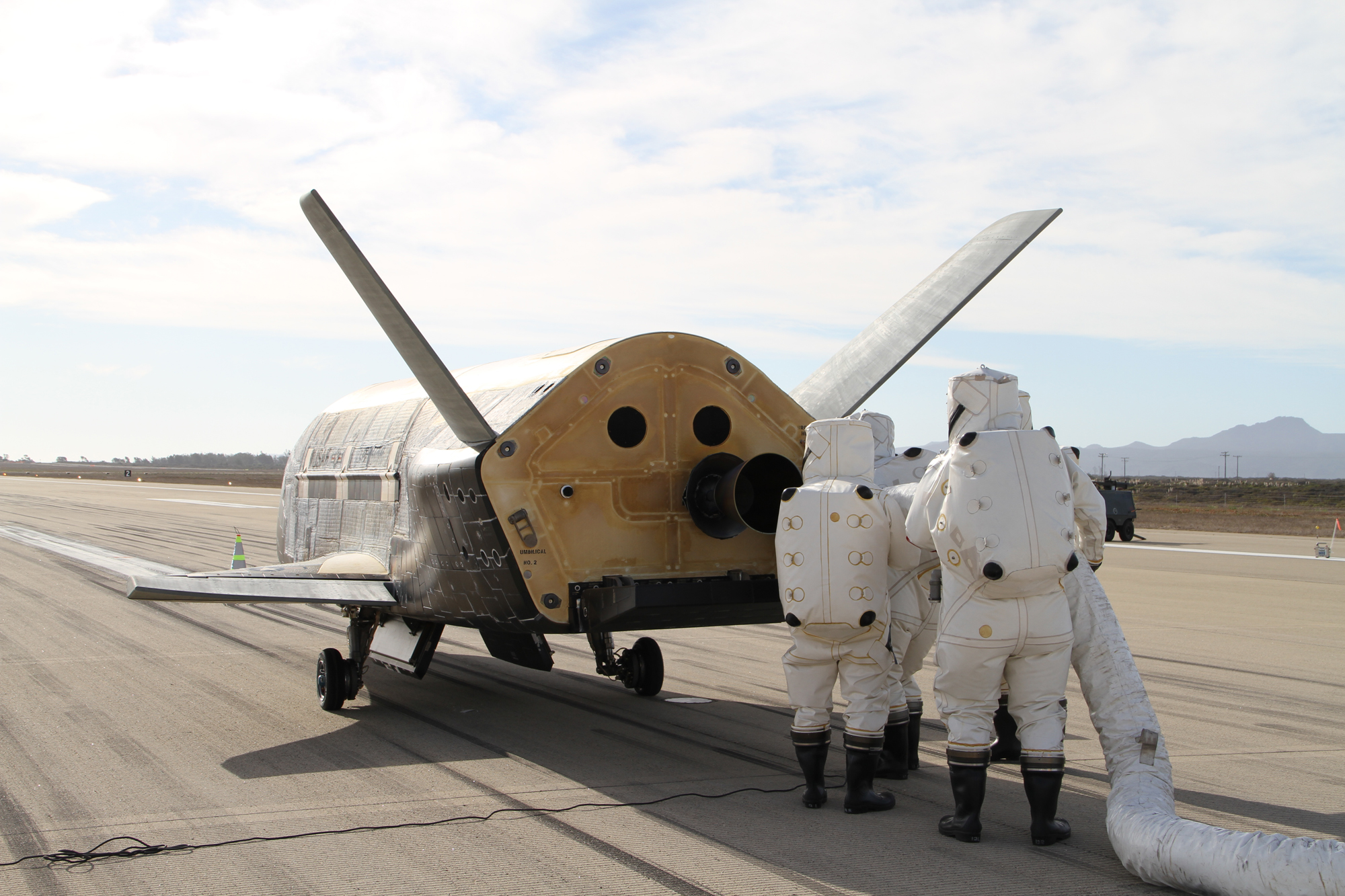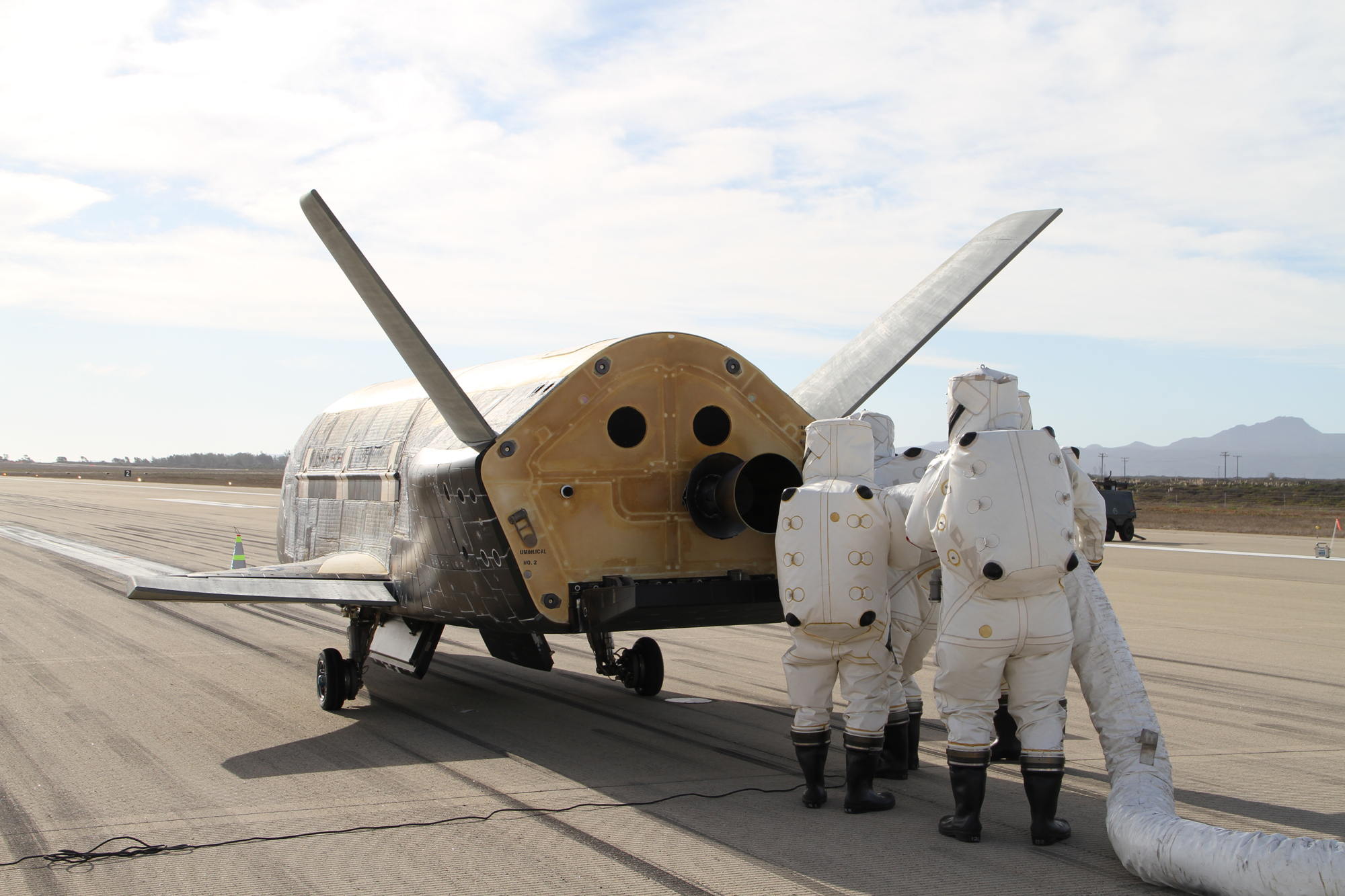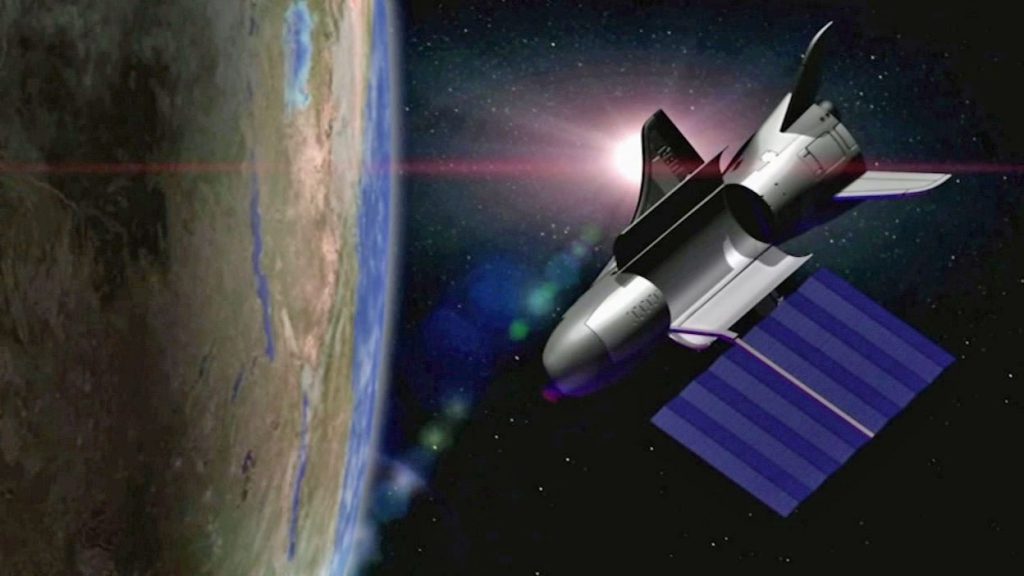

The U.S. military's X-37B robotic space plane, now nearing two years in orbit, is conducting "a regularly scheduled exercise this week," not preparing for landing as some reports have suggested, the Air Force said today (Feb. 14).
Earlier today, NASASpaceflight.com (an aerospace industry website) reported that the fourth X-37B mission was due to end with a touchdown at Kennedy Space Center's Shuttle Landing Facility as early as 7:48 a.m. EST (1248 GMT).
The landing would have been the first Florida touchdown by an X-37B vehicle; the previous three landings occurred at Vandenberg Air Force Base in California.
However, Air Force officials told Space.com that these reports were inaccurate. "The X-37 is still on-orbit. The program is conducting a regularly scheduled exercise this week," the Air Force wrote in an email.
The Air Force has two X-37B vehicles, which are refurbished and prepared for flight in two of NASA's old space shuttle processing hangars that have been leased by Boeing, the Air Force's main X-37B contractor.
The X-37B presently in orbit blasted off aboard an Atlas V rocket on May 20, 2015.
The spaceships, also known as Orbital Test Vehicles (OTVs), are about one-quarter the size of the space shuttle orbiters and are designed to remain in orbit for at least 270 days.
Details of the program are classified, but the Air Force says the vehicles are used to demonstrate technologies for reliable and reusable uncrewed spacecraft and to operate experiments that can be returned and analyzed on Earth.
The program has its roots in a NASA technology development effort that ran from 1999 to 2004 before it was picked up by the U.S. Department of Defense's Defense Advanced Research Projects Agency (DARPA) and later transferred to the Air Force Rapid Capabilities Office.
The first X-37B vehicle made its orbital debut in 2010, circling the planet for 224 days before landing at Vandenberg Air Force Base, blowing a tire in the process.
The second vehicle launched the following March and ended up staying in orbit more than twice as long as its sister ship, touching down in California after 469 days aloft. OTV-3, which launched on Dec. 11, 2012, marked the first re-flight of an X-37B. That mission lasted nearly 675 days.
Quelle: SC
---
The X-37 isn’t landing just yet

WASHINGTON — The U.S. Air Force’s classified spaceplane, the X-37B, is probably not landing today despite earlier rumors that it would.
“The X-37 is still on-orbit. The program is conducting a regularly scheduled exercise this week,” said a statement from Air Force spokeswoman Capt. Annmarie Annicelli.
Several websites reported Tuesday morning that the craft was maneuvering in possible preparation for a landing, but it appears instead to be taking part in a planned exercise.
This is the fourth mission for the top-secret, Boeing-built spaceplane. It launched May 20, 2015. There are actually two spacecraft, according to the Air Force, each about 29 feet long and 9 feet high, with a 14-foot wingspan, and clocking in at 11,000 pounds each.
The two spacecraft have alternated flying missions since the first one launched in April 2010.
According to previous information provided by the Air Force, the spaceplanes are testing out “advanced guidance, navigation and control, thermal protection systems, avionics, high temperature structures and seals, conformal reusable insulation, lightweight electromechanical flight systems, advanced propulsion systems, and autonomous orbital flight, reentry, and landing.”
Quelle: SN
---
No imminent X-37B landing planned

CAPE CANAVERAL — The enigmatic X-37B spaceplane, launched into low-Earth orbit on an experimental military mission in 2015, continues to circle the planet despite a flurry of landing rumors.
“The X-37 is still on-orbit. The program is conducting a regularly scheduled exercise this week,” said Capt. Annmarie Annicelli, media operations officer at the Pentagon’s Air Force Press Desk.
Internet chatter buzzed in recent days about a potential landing of the stubby-winged spacecraft at the Kennedy Space Center’s Shuttle Landing Facility as early as this morning.
But the Pentagon put those rumors to rest with its brief but pointed statement.
The X-37B was launched on May 20, 2015 and spent its 636th day in space today on a classified mission.
This fourth flight of the unmanned and reusable spaceplane program carried at least two payloads on its latest voyage. The military revealed before the ship took off that it was carrying an experimental electric propulsion thruster to be tested in orbit and a pallet to expose sample materials to the space environment.
What else, if anything, the vehicle is carrying in its pickup truck-size cargo bay is unknown.
As of today, the X-37B program has used twin reusable vehicles to amass 2,004 cumulative days in space on four flights since 2010, launching like a satellite atop Atlas 5 rockets and then landing like an airplane.
The three previous flights landed at Vandenberg Air Force Base in California. But the Air Force and builder Boeing have worked to consolidate all X-37B launch and landing operations at the Kennedy Space Center to use the former hangars and runway from the now-retired civilian program.
Quelle: SN
---
Update: 18.03.2017
.
Air Force's Mysterious X-37B Space Plane Nears Orbital Record
What do you think the U.S. Air Force's robotic X-37B space planes are doing on their months-long mystery missions in orbit?
If the robotic vehicle stays aloft until March 25, it will break the X-37B mission-duration mark of 674 days, which was established back in October 2014.
It's unclear whether that will actually happen, however; the Air Force is tight-lipped about most X-37B payloads and activities, including touchdown plans. [The X-37B's Fourth Mystery Mission in Photos]
"The landing date will be determined based on the completion of the program's on-orbit demonstrations and objectives for this mission," Capt. AnnMarie Annicelli, an Air Force spokeswoman, told Space.com via email when asked when the current mission might end.


The uncrewed X-37B (also known as the Orbital Test Vehicle, or OTV) looks a lot like NASA's now-retired space shuttle, only much smaller. The X-37B is just 29 feet (8.8 meters) long and 9.6 feet (2.9 m) tall, with a wingspan of about 15 feet (4.6 m). Two of the vehicles could fit inside a space shuttle's payload bay.
The Air Force is known to have two X-37Bs, both of which were built by Boeing. These twin craft have flown four missions to date. OTV-1 launched on April 22, 2010, and landed on Dec. 3 of that year, spending 224 days in orbit. OTV-2 started on March 5, 2011, and wrapped up on June 16, 2012, after 468 days in space. OTV-3 launched on Dec. 11, 2012, and landed on Oct. 17, 2014, after circling the Earth for more than 674 days.
The current mission, OTV-4, lifted off on May 20, 2015.

All four X-37B flights have launched from Florida's Cape Canaveral Air Force Station, and the first three landed at Vandenberg Air Force Base in California. But the Air Force has been working to consolidate X-37B launch and landing activities on Florida's Space Coast, and that vision includes bringing the vehicles down at the Shuttle Landing Facility at NASA's Kennedy Space Center (KSC), which is next door to Cape Canaveral. [The X-37B Space Plane: 6 Surprising Facts]
Rumors have swirled that OTV-4 will land at KSC, but that's all they are at the moment — rumors. Capt. Annicelli declined to confirm or refute such speculation.
"While the program has the capability to land at either KSC or Vandenberg, the landing location is determined by a variety of factors," she said.
Because of the secrecy surrounding the X-37B program, some people have speculated that the vehicle is a space weapon. But the Air Force has always vigorously contested such claims, saying that the space plane is simply testing technologies and helping researchers conduct in-space experiments.
"Technologies being tested in the program include advanced guidance, navigation and control, thermal-protection systems, avionics, high-temperature structures and seals, conformal reusable insulation, lightweight electromechanical flight systems, advanced propulsion systems and autonomous orbital flight, re-entry, and landing," the Air Force's X-37B fact sheet states.
Quelle: SC
---
Update: 25.03.2017
.
Air Force's Mysterious X-37B Space Plane Breaks Orbital Record
The ongoing mission of the U.S. Air Force's robotic X-37B space plane is now the longest in the clandestine program's history.
As of today (March 25), the X-37B has spent 675 days on its latest Earth-circling mission, which is known as Orbital Test Vehicle-4 (OTV-4). The previous record was 674 days, set during OTV-3, which lasted from December 2012 to October 2014.
It's unclear what the new duration record will end up being; most X-37B activities and payloads are classified, and the Air Force has historically been tight-lipped about landing plans.
"The landing date will be determined based on the completion of the program's on-orbit demonstrations and objectives for this mission," Capt. AnnMarie Annicelli, an Air Force spokeswoman, told Space.com via email.
OTV-4 is still nowhere near the overall record for longest space mission, however. Some Earth-observation satellites have operated for decades; for example, Landsat-5 studied the planet from 1984 to 2013. And NASA's far-flung Voyager 1 and Voyager 2 probes are still sending data home, nearly 40 years after their 1977 launches.
Mini-shuttle mystery missions
What do you think the U.S. Air Force's robotic X-37B space planes are doing on their months-long mystery missions in orbit?
The Air Force vehicle also looks like a miniature version of the space shuttle. Each solar-powered X-37B is just 29 feet (8.8 meters) long and 9.6 feet (2.9 m) tall, with a wingspan of about 15 feet (4.6 m). For comparison, the space shuttle was about 122 feet (37 m) long, with a wingspan of 78 feet (24 m).
Together, these two X-37Bs have flown four space missions to date, each of which has set a new duration record. OTV-1 launched on April 22, 2010, and landed on Dec. 3 of that year, spending a total of 224 days in orbit; OTV-2 lifted off on March 5, 2011, and wrapped up on June 16, 2012 (468 days); OTV-3 launched on Dec. 11, 2012, and landed on Oct. 17, 2014 (674 days); and OTV-4 lifted off on May 20, 2015. (The mission lengths of OTV-3 and OTV-4 may seem equivalent as of today, but the former landed about 2 hours shy of the full 675-day mark.)
The latest three missions have therefore blown past the space plane's designed orbital lifetime, which is just 270 days, according to the Air Force's X-37B fact sheet.


The secrecy surrounding the X-37B program has led to some speculation that the vehicle may be a space weapon. But this is unlikely to be true, experts say; for example, the space plane does not seem big enough or maneuverable enough to be used to manipulate other satellites.
Indeed, the Air Force has always stressed that the X-37B has two primary objectives: testing reusable spacecraft technologies, and helping to conduct experiments that can be returned to Earth for examination.
"Technologies being tested in the program include advanced guidance, navigation and control; thermal
protection systems; avionics; high-temperature structures and seals; conformal reusable insulation, lightweight electromechanical flight systems; and autonomous orbital flight, re-entry and landing," Annicelli told Space.com, declining to offer details about OTV-4 in particular.
"Also, the Air Force Research Laboratory (AFRL), Space and Missile Systems Center (SMC) and the Air Force Rapid Capabilities Office (AFRCO) are investigating an experimental propulsion system," she added.

A Florida landing?
All four X-37B missions have launched from Florida's Cape Canaveral Air Force Station. The first three touched down at Vandenberg Air Force Base in California, but OTV-4 might not.
Air Force officials have said they aim to consolidate X-37B launch and landing activities on Florida's Space Coast. To this end, the old Shuttle Landing Facility at NASA's Kennedy Space Center (KSC), which is right next door to Cape Canaveral, has been prepped to accommodate the X-37B.
If OTV-4 does come down at KSC, it would mark the first landing at the site since July 2011, when the space shuttle Atlantis touched down to wrap up its STS-135 mission — the shuttle program's last-ever flight.
Quelle: SC
---
Update: 1.04.2017
.
The X-37B: America's Amazing Space Plane (That Russia and China Fear)

A mysterious space plane has spent more than 670 days above Earth, hurtling along an orbital path that includes some of the world’s most volatile hotspots. Known the X-37B, the U.S. Air Force’s unmanned mini-shuttle whizzes along an average of two hundred miles above the surface of the Earth. Exactly what it’s doing up there is bit of a mystery.
The space plane that would eventually become the X-37B was originally conceived of by NASA in 1999. The Space Shuttle program had failed to bring down the per-pound cost of ferrying a payload to orbit, but a smaller, unmanned aircraft using newer technologies might prove more economical. Boeing’s Phantom Works division was given a four-year contract to develop the X-37 in conjunction with NASA, followed up in 2002 with a new agreement to develop an Approach and Landing Test Vehicle to test horizontal landing concepts. Once successful, that would be followed up with an actual Orbital Test Vehicle, a launch into space, and a Space Shuttle–like landing.
In 2004 NASA transferred the X-37 program to the Defense Advanced Research Projects Agency, known as DARPA. The ALTV vehicle successfully tested out atmospheric flight concepts, but NASA’s OTV space plane was never built. Instead, the U.S. Air Force built its own OTV space plane along the same lines. In fact, it built at least two.
The X-37 is lifted into space by a United Launch Alliance Atlas V rocket using Russian-supplied RD-180 liquid-fuel rocket boosters. It sits at the top of the rocket, encased in an aerodynamic payload fairing. The X-37 is twenty-nine feet, three inches long, with a wingspan of fourteen feet, eleven inches; it weighs five tons at launch. Its payload bay is seven feet long by seven feet wide—about the same as a pickup truck. In orbit, the space plane is powered by gallium arsenide solar cells with lithium-ion batteries.
According to the Air Force, the space plane tests a variety of technologies, including “advanced guidance, navigation and control, thermal protection systems, avionics, high temperature structures and seals, conformal reusable insulation, lightweight electromechanical flight systems, advanced propulsion systems and autonomous orbital flight, reentry and landing.” The missions are run on the ground by Third Space Experimentation Squadron at Schriever Air Force Base in Colorado.
The first space plane flight, OTV-1, launched from Cape Canaveral on April 22, 2010 on an Atlas V named AV-012. The web site NASA Spaceflight speculated that the spacecraft was carrying a payload of “technology demonstration and development experiments” for the Air Force’s Rapid Capabilities Office. OTV-1 would spend 224 days in space.
The X-37 was originally designed to spend up to nine months in space, but the Air Force quickly pushed beyond that threshold. The second mission, OTV-2 was the first flight of the second X-37B, and lasted from March 5, 2011 to June 16, 2012, a total of 469 days. OTV-3 was launched in December 2012 and returned on October 17, 2014, for a total of 675 days.
OTV-4 was launched on May 20, 2015, and has been up in space ever since.
What are the X-37s doing up there? There have been all sorts of theories. One theory was that the X-37 has been sidling up to the military satellites of potential adversaries such as China and Russia, examining them and even returning to American soil with them safely tucked into the payload bay. While this Blofeld-style act of orbital grand theft fires the imagination, the truth is that the X-37’s orbit is fairly easy to track and such a heist would take place literally in front of the entire planet.
Other theories are that the X-37 is a form of nuclear space bomber, loaded with nuclear bombs or even “Rods from God”—kinetic energy projectiles dropped from space that accelerate to hypersonic speeds, obliterating their targets on Earth. Parked in orbit for months at a time, the X-37 could provide a quick means of delivering devastation, faster than ICBM and more difficult to detect.
The last “sexy” theory is that the space plane is basically a spy satellite with the ability to return to Earth and have its optical sensors periodically upgraded. The X-37 has orbited over some interesting locations, including North Korea, China, ISIS-held territory and Iran. U.S. optical spy satellites are, however, quite large—the size of a school bus—and the X-37’s payload bay is far too small.
The most likely purpose for the X-37B is simply to do space research. The payloads of earlier missions remain unknown. According to the Air Force, OTV-4 is testing Hall thruster electric propulsion systems, the same systems used on the Pentagon’s Advanced Extremely High Frequency communications satellite. Hall thrusters use a magnetic field to accelerate the ions in a propellant, producing thrust. Hall thrusters are used to adjust the orbits of satellites and are a “serious candidate” to power ships to Mars. OTV-4 is also carrying one hundred NASA-supplied materials to see how they hold up to the rigors of long-term space travel. Could it be up to even more things? It’s possible, but they’d have to be physically small.
While it may not be doing any satellite snatching, the X-37B program provides the Air Force with a flying, returnable test bed for testing new technologies, a capability no other country has at this point. Even if it isn’t carrying out any cloak-and-dagger missions, it’s still performing a valuable service that will advance American space technology.
Quelle: THE NATIONAL INTEREST
